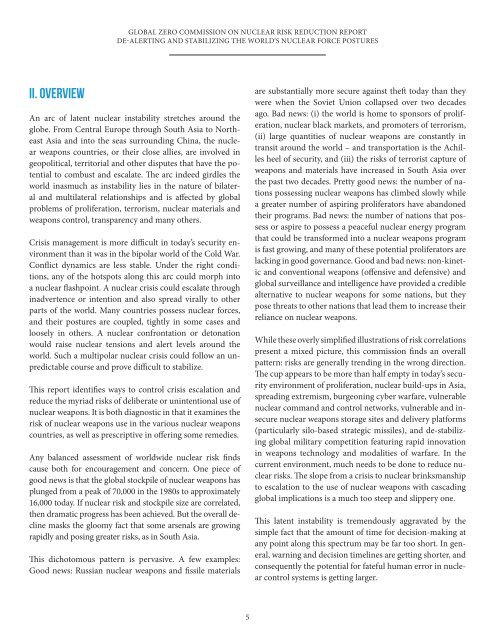global_zero_commission_on_nuclear_risk_reduction_report
global_zero_commission_on_nuclear_risk_reduction_report
global_zero_commission_on_nuclear_risk_reduction_report
Create successful ePaper yourself
Turn your PDF publications into a flip-book with our unique Google optimized e-Paper software.
GLOBAL ZERO COMMISSION ON NUCLEAR RISK REDUCTION REPORTDE-ALERTING AND STABILIZING THE WORLD’S NUCLEAR FORCE POSTURESII. OVERVIEWAn arc of latent <strong>nuclear</strong> instability stretches around theglobe. From Central Europe through South Asia to NortheastAsia and into the seas surrounding China, the <strong>nuclear</strong>weap<strong>on</strong>s countries, or their close allies, are involved ingeopolitical, territorial and other disputes that have the potentialto combust and escalate. The arc indeed girdles theworld inasmuch as instability lies in the nature of bilateraland multilateral relati<strong>on</strong>ships and is affected by <str<strong>on</strong>g>global</str<strong>on</strong>g>problems of proliferati<strong>on</strong>, terrorism, <strong>nuclear</strong> materials andweap<strong>on</strong>s c<strong>on</strong>trol, transparency and many others.Crisis management is more difficult in today’s security envir<strong>on</strong>mentthan it was in the bipolar world of the Cold War.C<strong>on</strong>flict dynamics are less stable. Under the right c<strong>on</strong>diti<strong>on</strong>s,any of the hotspots al<strong>on</strong>g this arc could morph intoa <strong>nuclear</strong> flashpoint. A <strong>nuclear</strong> crisis could escalate throughinadvertence or intenti<strong>on</strong> and also spread virally to otherparts of the world. Many countries possess <strong>nuclear</strong> forces,and their postures are coupled, tightly in some cases andloosely in others. A <strong>nuclear</strong> c<strong>on</strong>fr<strong>on</strong>tati<strong>on</strong> or det<strong>on</strong>ati<strong>on</strong>would raise <strong>nuclear</strong> tensi<strong>on</strong>s and alert levels around theworld. Such a multipolar <strong>nuclear</strong> crisis could follow an unpredictablecourse and prove difficult to stabilize.This <strong>report</strong> identifies ways to c<strong>on</strong>trol crisis escalati<strong>on</strong> andreduce the myriad <strong>risk</strong>s of deliberate or unintenti<strong>on</strong>al use of<strong>nuclear</strong> weap<strong>on</strong>s. It is both diagnostic in that it examines the<strong>risk</strong> of <strong>nuclear</strong> weap<strong>on</strong>s use in the various <strong>nuclear</strong> weap<strong>on</strong>scountries, as well as prescriptive in offering some remedies.Any balanced assessment of worldwide <strong>nuclear</strong> <strong>risk</strong> findscause both for encouragement and c<strong>on</strong>cern. One piece ofgood news is that the <str<strong>on</strong>g>global</str<strong>on</strong>g> stockpile of <strong>nuclear</strong> weap<strong>on</strong>s hasplunged from a peak of 70,000 in the 1980s to approximately16,000 today. If <strong>nuclear</strong> <strong>risk</strong> and stockpile size are correlated,then dramatic progress has been achieved. But the overall declinemasks the gloomy fact that some arsenals are growingrapidly and posing greater <strong>risk</strong>s, as in South Asia.This dichotomous pattern is pervasive. A few examples:Good news: Russian <strong>nuclear</strong> weap<strong>on</strong>s and fissile materialsare substantially more secure against theft today than theywere when the Soviet Uni<strong>on</strong> collapsed over two decadesago. Bad news: (i) the world is home to sp<strong>on</strong>sors of proliferati<strong>on</strong>,<strong>nuclear</strong> black markets, and promoters of terrorism,(ii) large quantities of <strong>nuclear</strong> weap<strong>on</strong>s are c<strong>on</strong>stantly intransit around the world – and transportati<strong>on</strong> is the Achillesheel of security, and (iii) the <strong>risk</strong>s of terrorist capture ofweap<strong>on</strong>s and materials have increased in South Asia overthe past two decades. Pretty good news: the number of nati<strong>on</strong>spossessing <strong>nuclear</strong> weap<strong>on</strong>s has climbed slowly whilea greater number of aspiring proliferators have aband<strong>on</strong>edtheir programs. Bad news: the number of nati<strong>on</strong>s that possessor aspire to possess a peaceful <strong>nuclear</strong> energy programthat could be transformed into a <strong>nuclear</strong> weap<strong>on</strong>s programis fast growing, and many of these potential proliferators arelacking in good governance. Good and bad news: n<strong>on</strong>-kineticand c<strong>on</strong>venti<strong>on</strong>al weap<strong>on</strong>s (offensive and defensive) and<str<strong>on</strong>g>global</str<strong>on</strong>g> surveillance and intelligence have provided a crediblealternative to <strong>nuclear</strong> weap<strong>on</strong>s for some nati<strong>on</strong>s, but theypose threats to other nati<strong>on</strong>s that lead them to increase theirreliance <strong>on</strong> <strong>nuclear</strong> weap<strong>on</strong>s.While these overly simplified illustrati<strong>on</strong>s of <strong>risk</strong> correlati<strong>on</strong>spresent a mixed picture, this <str<strong>on</strong>g>commissi<strong>on</strong></str<strong>on</strong>g> finds an overallpattern: <strong>risk</strong>s are generally trending in the wr<strong>on</strong>g directi<strong>on</strong>.The cup appears to be more than half empty in today’s securityenvir<strong>on</strong>ment of proliferati<strong>on</strong>, <strong>nuclear</strong> build-ups in Asia,spreading extremism, burge<strong>on</strong>ing cyber warfare, vulnerable<strong>nuclear</strong> command and c<strong>on</strong>trol networks, vulnerable and insecure<strong>nuclear</strong> weap<strong>on</strong>s storage sites and delivery platforms(particularly silo-based strategic missiles), and de-stabilizing<str<strong>on</strong>g>global</str<strong>on</strong>g> military competiti<strong>on</strong> featuring rapid innovati<strong>on</strong>in weap<strong>on</strong>s technology and modalities of warfare. In thecurrent envir<strong>on</strong>ment, much needs to be d<strong>on</strong>e to reduce <strong>nuclear</strong><strong>risk</strong>s. The slope from a crisis to <strong>nuclear</strong> brinksmanshipto escalati<strong>on</strong> to the use of <strong>nuclear</strong> weap<strong>on</strong>s with cascading<str<strong>on</strong>g>global</str<strong>on</strong>g> implicati<strong>on</strong>s is a much too steep and slippery <strong>on</strong>e.This latent instability is tremendously aggravated by thesimple fact that the amount of time for decisi<strong>on</strong>-making atany point al<strong>on</strong>g this spectrum may be far too short. In general,warning and decisi<strong>on</strong> timelines are getting shorter, andc<strong>on</strong>sequently the potential for fateful human error in <strong>nuclear</strong>c<strong>on</strong>trol systems is getting larger.5


